

S Kepler Discovers First Earth-Size Planet In The 'Habitable Zone' of Another Star. [image-36] [image-51] Using NASA's Kepler Space Telescope, astronomers have discovered the first Earth-size planet orbiting a star in the "habitable zone" -- the range of distance from a star where liquid water might pool on the surface of an orbiting planet.

The discovery of Kepler-186f confirms that planets the size of Earth exist in the habitable zone of stars other than our sun. While planets have previously been found in the habitable zone, they are all at least 40 percent larger in size than Earth and understanding their makeup is challenging. This Is The Milky Way Like You've Never Seen It Before. Potential Martians: Mars One selects 1,058 hopefuls among 200,000 applicants. Juno captured starship-like view of Earth and moon.
Earth and moon as captured by the Juno spacecraft as it flew by Earth on October 9, 2013.
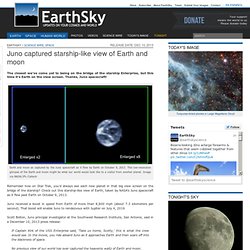
This low-resolution glimpse of the Earth and moon might be what our world would look like to a visitor from another planet. Image via NASA/JPL-Caltech Remember how on Star Trek, you’d always see each new planet in that big view screen on the bridge of the starship? Check out this starship-like view of Earth, taken by NASA’s Juno spacecraft as it flew past Earth on October 9, 2013. Amazing photo: Frog photobombs NASA moon launch. NASA’s Deep Impact spacecraft is spinning out of control. Ball Aerospace & Technologies Corp.
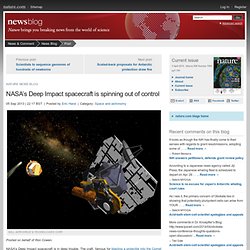
Posted on behalf of Ron Cowen. NASA’s Deep Impact spacecraft is in deep trouble. Massive solar flare narrowly misses Earth, EMP disaster barely avoided. The earth barely missed taking a massive solar punch in the teeth two weeks ago, an "electromagnetic pulse" so big that it could have knocked out power, cars and iPhones throughout the United States.

Two EMP experts told Secrets that the EMP flashed through earth's typical orbit around the sun about two weeks before the planet got there. "The world escaped an EMP catastrophe," said Henry Cooper, who led strategic arms negotiations with the Soviet Union under President Reagan, and who now heads High Frontier, a group pushing for missile defense. "There had been a near miss about two weeks ago, a Carrington-class coronal mass ejection crossed the orbit of the Earth and basically just missed us," said Peter Vincent Pry, who served on the Congressional EMP Threat Commission from 2001-2008. He was referring to the 1859 EMP named after astronomer Richard Carrington that melted telegraph lines in Europe and North America. Astronomers Find Ancient Star 'Methuselah' Which Appears To Be Older Than The Universe.
Scientists have discovered an "impossible" star which appears to be older than the universe.

Oddly enough, Methuselah is even located inside our own galaxy - about 190 light years away. And even after using new information about the star's distance from us, its brightness and its structure, scientists are unable to place an estimate of its age much below 14.5 billion years - still older than the universe. Fortunately for the team from Pennsylvania State University and the Space Telescope Science Institute in Baltimore, there appears to be a margin of error of about 800 million years, or so - enough to just barely place the star below the age of everything else, if peace of mind is important to you.
Formally known as HD 140283, the star is the oldest object currently known to astronomers. It was first discovered a century ago, moving more than 800,000 mph relative to our solar system. The study suggests that further research might bring the age of the star down even further. Gang of Asteroids: Russian meteor may have followers on same path. NASA Warp Drive Project - "Speeds" that Could Take a Spacecraft to Alpha Centauri in Two Weeks. How NASA might build its very first warp drive. NASA's Warp Drive Project: "Speeds" That Could Take a Spacecraft to Alpha Centauri in Two Weeks Even Though the System is 4.3 Light-Years Away.
(Before It's News) NASA’s Warp Drive Project: “Speeds” that Could Take a Spacecraft to Alpha Centauri in Two Weeks — Even Though the System is 4.3 Light-Years Away.
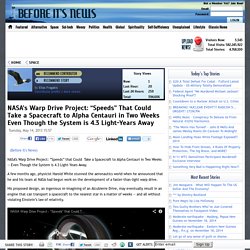
A few months ago, physicist Harold White stunned the aeronautics world when he announced that he and his team at NASA had begun work on the development of a faster-than-light warp drive. His proposed design, an ingenious re-imagining of an Alcubierre Drive, may eventually result in an engine that can transport a spacecraft to the nearest star in a matter of weeks — and all without violating Einstein’s law of relativity. The above image of a Vulcan command ship features a warp engine similar to an Alcubierre Drive. Image courtesy CBS. Mysterious Extragalactic Explosions Baffle Astronomers. Powerful and puzzling radio blasts in other galaxies constantly explode across the night sky, a new study suggests.
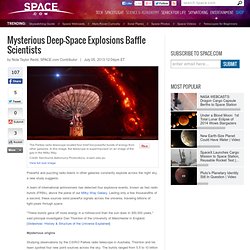
A team of international astronomers has detected four explosive events, known as fast radio bursts (FRBs), above the plane of our Milky Way Galaxy. Lasting only a few thousandths of a second, these sources send powerful signals across the universe, traveling billions of light-years through space. "These bursts gave off more energy in a millisecond than the sun does in 300,000 years," said principal investigator Dan Thornton of the University of Manchester in England. [Slideshow: History & Structure of the Universe Explained] Mysterious origins Studying observations by the CSIRO Parkes radio telescope in Australia, Thornton and his team spotted four new point sources across the sky.
UFO Footage So Clear You Can See The Pilot. Gravity. First pictures of Earth from Saturn released. On Friday, the Cassini spacecraft took pictures of Earth and moon from nearly 900 million miles (nearly 1.5 billion kilometers).
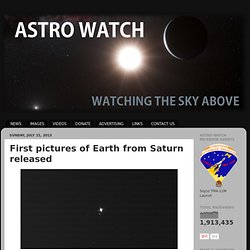
NASA began posting the raw images yesterday, and we’re also beginning to see color composite images (posted below). These are are only the third-ever images of Earth from the outer solar system. Voyager 1 got the first Earth image from 4 billion miles (6 billion kilometers away) in 1990, showing Earth as a pale blue dot. Cassini got the second, during an eclipse of the sun by Saturn in 2006, from 926 million miles (1.49 billion kilometers). As NASA's Cassini spacecraft turned its imaging cameras to Earth, scientists, engineers and visitors at NASA's Jet Propulsion Laboratory, Pasadena, Calif., gathered to wave at a robotic photographer in the Saturn system on July 19, 2013.
A Black Hole´s Dinner. FOX News - Science - Latest Headlines - NASA to light skies over East Coast tonight. NASA will launch a rocket tonight (Jan. 29) on a mission that promises to put on a spectacular, albeit brief, light show over the U.S.

East Coast that may be visible to stargazers along the Atlantic Seaboard, weather permitting. Unsuspecting observers of the artificial night sky display may be puzzled and amazed, so before you make that phone call to your local media outlet or police station, here is why this is happening and when you might see it. Will Bright Comet ISON Sizzle or Fizzle This Year? The newly discovered Comet ISON is just a faint speck in the sky right now, but later this year, when it flies closer to the sun, it could shine as bright as the moon and may even be visible in broad daylight, scientists say.
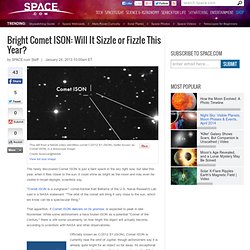
"Comet ISON is a sungrazer," comet-tracker Karl Battams of the U.S. Naval Research Lab said in a NASA statement. "The orbit of the comet will bring it very close to the sun, which we know can be a spectacular thing. " That apparition, if Comet ISON delivers on its promise, is expected to peak in late November.
Cool things I like. Astronomers Discover a Planet Almost Identical to Earth. Facebook. Christianity. Announces Next Steps in Effort to Launch Americans from U.S. Soil. RELEASE : 12-263 NASA Announces Next Steps in Effort to Launch Americans from U.S. Soil CAPE CANAVERAL, Fla. -- NASA Friday announced new agreements with three American commercial companies to design and develop the next generation of U.S. human spaceflight capabilities, enabling a launch of astronauts from U.S. soil in the next five years. Advances made by these companies under newly signed Space Act Agreements through the agency's Commercial Crew Integrated Capability (CCiCap) initiative are intended to ultimately lead to the availability of commercial human spaceflight services for government and commercial customers. CCiCap partners are: -- Sierra Nevada Corporation, Louisville, Colo., $212.5 million -- Space Exploration Technologies (SpaceX), Hawthorne, Calif., $440 million -- The Boeing Company, Houston, $460 million.